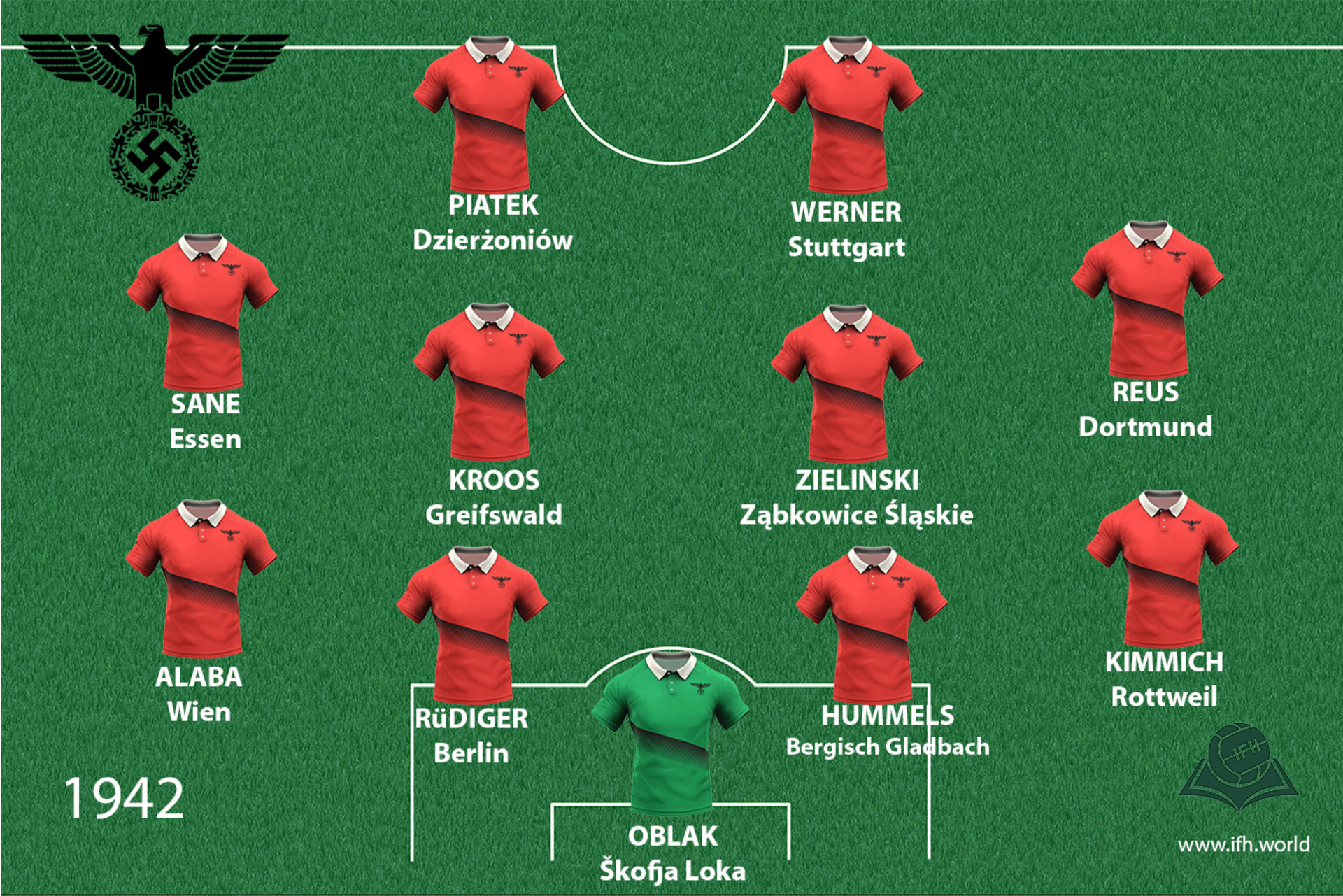German Reich
Hitler and the rise of Nazism were not just a mere aberration, an unexpected “intruder”, in this episode of the history of Germany. Nazi ideology was a combination of volkisch nationalism, Teutonism and social Darwinism, tied closely to eugenics. They all developed and were present within the western European and German society for centuries before the emergence of the National Socialist Party.

Coat of arms
Shirt
| Position | First name | Last name | Mjesto rođenja | Like | Dislike |
|---|
Difficult times did not by themselves turn people to Nazism. Nazism had a social program for the masses, the government liquidated the economic crisis, rejected the Peace treaty of Versailles, etc. Nazi success in winning over the masses also lies in emphasizing the values of community, i.e. the strength of the collective, to which an individual must be subordinated. The Germans praised Hitler, while Hitler praised them.[1]
Nazism was a political religion, whose creation was the answer to the “crisis of meaning” in people, i.e. a doctrine that aimed to take the place of religion in the souls of its followers.[2]Like a religion, the Nazis invented holidays, extoling the cult of the Führer, martyrs (e.g. “Memorial day of the fallen fighters” on November 9th), developed their own system of unquestionable dogmas, sermons, holy rituals and sublime phrases that offer a complete explanation of the past, present and future, demanding complete dedication of their followers.[3]
Nazis were advocates of the so-called volkisch nationalism, created at the same time as the other national ideologies in the 19th century, that does not want tot assimilate or impose its own culture on other peoples. It wants to separate the German people from others, insisting on Germans not mixing with other peoples because that, according to it, leads to cultural, political, and racial downfall.[4] The term Volk starts to be connected to blood (Blut), which means one could be a member of the German people only if one was related by blood to a German.[5] Ideologists of the volkisch movement claimed that Germanic peoples were descendants of the ancient conquerors of India, who had light complexion, and for whom the term “Aryans” was coined in the 19th century. They began creating myths about them as ideal people with superior qualities.[6]
Connected to this, Nazis disseminated Germanic national physiognomy (strong, blond-haired, blue-eyed Germanic peoples) formed by the ideologists of Teutonism in the age of humanism, based on descriptions of the Germanic peoples from the works of ancient historian Tacitus.[7]
Furthermore, they connected the ideology of the volkisch movement with eugenics since, according to their understanding, the threat for the future of the German people came not only from mixing races, but also from within, through the reproduction of “lesser beings”. This is the reason for sterilizing or killing thousands of German citizens (handicapped, mentally ill, schizophrenic, blind, deaf and alcoholics). The idea of selection of people was already on the forefront of medical thought in the Western world,[8] and liberal countries like Sweden and the USA led the forced sterilization of recidivists, especially African Americans.[9] Nazi Germany, however, was the most well-known example of implementation of the ideas of eugenic societies since they were implemented publicly and loudly.
Hitler had a vision of creating a New World Order led by the Great German Empire that would encompass all territories where Germanic peoples lived, plus the expanses of Eastern Europe (mostly at the expense of Slavic peoples), where he intended to create the Lebensraum (living space) for the Germanic peoples. The concept of Lebensraum as a geographic justification for the struggle to live, i.e. biology applied to geography, was developed, at the misfortune of the “primitive peoples”, by the German geographer Friedrich Ratzel in the beginning of the 20th century.[10]
Communists represented the greatest political enemies for the Nazis, since Nazism placed the idea of creation of a superior German nation at its core, where communism placed internationalism and class struggle.[11]
A special place in the Nazi ideology was taken by the relationship toward Jews, who were marked as a foreign element and an obstacle in the construction of an old Germanic community tied with blood and race that German nationalists strived for.[12] To them, Jews were necessary as “the Others” and were presented as a foreign element that could easily assimilate into German society and, in so doing, corrupt it.[13] They were also presented as scapegoats to homogenize the nation through aggression by portraying them as the ones who were to blame for the difficult situation.[14] Hatred toward the Jews was an integral part of European Christian culture – Catholic, Orthodox and Protestant – all the way back to the middle ages, since when they were repressed through persecution, killing and isolation. With the emergence of nationalism as an ideology in the 19th century, a new form of hatred toward Jews emerges, seeing them as a foreign element in society that undermines the unity of a nation.[15] Since he considered Jews a race, not an ethnic/national minority or a religious group, Hitler had no obligation to justify measures undertaken against them since there were no laws against racial discrimination at the time.[16] Besides, racism was, at the time, very much present in Western democratic countries, especially the USA. Very soon, many people accepted the theory of Jews as a “different race” and people who formerly knew nothing about them started blaming them for every misfortune.[17]
- [1] Tihomir Cipek, lecture at the course 'Political propaganda in totalitarian regimes'' (Postgraduate university doctoral study “Politology”), Faculty of Political Science, Zagreb, 18.XI. 2013; Eric J. HOBSBAWM, Doba ekstrema : kratko dvadeseto stoljeće 1914.-1991, Zagreb, 2009, 119; Michael BURLEIGH, Treći Reich : nova povijest, Zaprešić, 2012 ,143
- [2] Emil Čić, ''Nove religije – hereze XX. i XXI.stoljeća i njihov utjecaj na Hrvatsku'', http://emilcic.exactpages.com/ideologija.html
- [3] Michael BURLEIGH, Treći Reich : nova povijest, Zaprešić, 2012 , 18
- [4] Michael BURLEIGH, Treći Reich : nova povijest, Zaprešić, 2012 , 120
- [5] Group of authors, Povijest: Predvečerje rata i Drugi svjetski rat (1936. - 1945.) , knjiga XVII., Zagreb 2008, 370
- [6] Georges BENSOUSSAN, Europska strast za genocidom : povijest genocidnih ideja i djela, Zagreb, 2010, 227; Marvin PERRY, '' Darvinizam-Rasizam-Antisemitizam'' ,https://teorijamodernosti2012.wordpress.com/2012/12/08/49/
- [7] Zrinka BLAŽEVIĆ, Ilirizam prije ilirizma, Zagreb, 2008, 74
- [8] Georges BENSOUSSAN, Europska strast za genocidom : povijest genocidnih ideja i djela, Zagreb, 2010, 100
- [9] (41 Anatomija fašizma)
- [10] Georges BENSOUSSAN, Europska strast za genocidom : povijest genocidnih ideja i djela, Zagreb, 2010, 120
- [11] Eric HOBSBAWM, Doba kapitala 1848-1875, Zagreb, 1989, 79
- [12] Alaster HAMILTON, Fašizam i intelektualci : 1919-1945., Belgrade, 1978, 139
- [13] Alaster HAMILTON, Fašizam i intelektualci : 1919-1945., Belgrade, 1978, 139
- [14] Tihomir Cipek, lecture at the course 'Political propaganda in totalitarian regimes'' (Postgraduate university doctoral study “Politology”), Faculty of Political Science, Zagreb, 18.XI. 2013
- [15] Milovan BALETIĆ, Ispunjenje zavjeta ili Povratak Židova u zemlju Izraelovu, Zagreb, 1982, 115; Georges BENSOUSSAN, Europska strast za genocidom : povijest genocidnih ideja i djela, Zagreb, 2010, 128
- [16] Višeslav ARALICA, ''što je nacija ustaškim intelektualcima?'', Nacija i nacionalizam u hrvatskoj povijesnoj tradiciji (ur. Tihomir Cipek, Josip Vrandečić), Zagreb, 2007, 281
- [17] Michael BURLEIGH, Treći Reich : nova povijest, Zaprešić, 2012., 375
Sources
- Višeslav ARALICA, ''što je nacija ustaškim intelektualcima?'', Nacija i nacionalizam u hrvatskoj povijesnoj tradiciji (ur. Tihomir Cipek, Josip Vrandečić), Zagreb, 2007.
- Milovan BALETIĆ, Ispunjenje zavjeta ili Povratak Židova u zemlju Izraelovu, Zagreb, 1982.
- Georges BENSOUSSAN, Europska strast za genocidom : povijest genocidnih ideja i djela, Zagreb, 2010.
- Zrinka BLAŽEVIĆ, Ilirizam prije ilirizma, Zagreb, 2008.
- Michael BURLEIGH, Treći Reich : nova povijest, Zaprešić, 2012
- Emil Čić, ''Nove religije – hereze XX. i XXI.stoljeća i njihov utjecaj na Hrvatsku'', http://emilcic.exactpages.com/ideologija.html
- Grupa autora, Povijest: Predvečerje rata i Drugi svjetski rat (1936. - 1945.) , knjiga XVII., Zagreb 2008.
- Alaster HAMILTON, Fašizam i intelektualci : 1919-1945., Beograd, 1978.
- Eric HOBSBAWM, Doba kapitala 1848-1875, Zagreb: Školska knjiga1989.
- Eric J. HOBSBAWM, Doba ekstrema : kratko dvadeseto stoljeće 1914.-1991, Zagreb, 2009
- Robert O.Paxton, Anatomija fašizma, Tim Press: Zagreb 2012.
- Marvin PERRY, '' Darvinizam-Rasizam-Antisemitizam'' ,https://teorijamodernosti2012.wordpress.com/2012/12/08/49/
- Tihomir Cipek, predavanje na kolegiju ''Politička propaganda u totalitarnim režimima'' (Poslijediplomski sveučilišni doktorski studij „Politologija“), Fakultet političkih znanosti, Zagreb, 18.XI. 2013.
